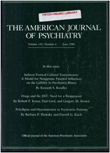High prevalence of intermittent acute porphyria in a psychiatric patient population
Abstract
The authors screened 3,867 psychiatric inpatients for intermittent acute porphyria by use of a spot test to detect diminished activity of the erythrocyte enzyme porphobilinogen (PBG) deaminase. Eighteen individuals so identified also had persistently diminished quantitative activity of PBG deaminase. Eight of these appeared to have intermittent acute porphyria by the added criteria of increased urinary delta- aminolevulinic acid or PBG or a family history of intermittent acute porphyria. The overall prevalence of intermittent acute porphyria was 0.21%, a considerably higher rate than that in the general population. Most of the subjects with the disorder had periods of agitated psychosis and apathetic or depressed withdrawal, with signs of neuropsychological impairment. Neurologic abnormalities were not prevalent.
Access content
To read the fulltext, please use one of the options below to sign in or purchase access.- Personal login
- Institutional Login
- Sign in via OpenAthens
- Register for access
-
Please login/register if you wish to pair your device and check access availability.
Not a subscriber?
PsychiatryOnline subscription options offer access to the DSM-5 library, books, journals, CME, and patient resources. This all-in-one virtual library provides psychiatrists and mental health professionals with key resources for diagnosis, treatment, research, and professional development.
Need more help? PsychiatryOnline Customer Service may be reached by emailing [email protected] or by calling 800-368-5777 (in the U.S.) or 703-907-7322 (outside the U.S.).



